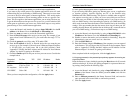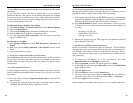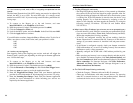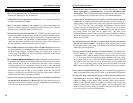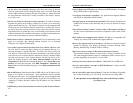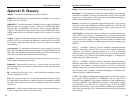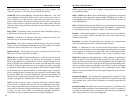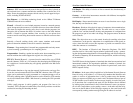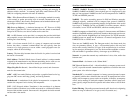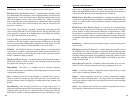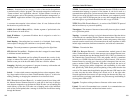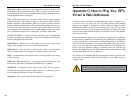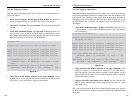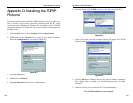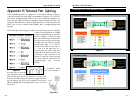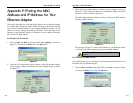
EtherFast
®
Cable/DSL Routers
NetBEUI (NetBIOS Extended User Interface) - The transport layer for
NetBIOS. NetBIOS and NetBEUI were originally part of a single protocol suite
that was later separated. NetBIOS sessions can be transported over NetBEUI,
TCP/IP, and SPX/IPX protocols.
NetBIOS - The native networking protocol in DOS and Windows networks.
Although originally combined with its transport layer protocol (NetBEUI),
NetBIOS today provides a programming interface for applications at the session
layer (layer 5). NetBIOS can ride over NetBEUI, its native transport, which is
not routable, or over TCP/IP and IPX/SPX, which are routable protocols.
NetBIOS computers are identified by a unique 15-character name, and Windows
machines (NetBIOS machines) periodically broadcast their names over the net-
work so that Network Neighborhood can catalog them. For TCP/IP networks,
NetBIOS names are turned into IP addresses via manual configuration in an
LMHOSTS file or a WINS server.
There are two NetBIOS modes. The Datagram mode is the fastest mode, but
does not guarantee delivery. It uses a self-contained packet with send and
receive name, usually limited to 512 bytes. If the recipient device is not listen-
ing for messages, the datagram is lost. The Session mode establishes a connec-
tion until broken. It guarantees delivery of messages up to 64KB long.
Network - A system that transmits any combination of voice, video, and/or data
between users.
Network Mask - also known as the “Subnet Mask.”
NIC (Network Interface Card) - A board installed in a computer system, usual-
ly a PC, to provide network communication capabilities to and from that com-
puter system. Also called an adapter.
Notebook (PC) - A notebook computer is a battery-powered personal comput-
er generally smaller than a briefcase that can easily be transported and conve-
niently used in temporary spaces such as on airplanes, in libraries, at temporary
offices, and at meetings. A notebook computer, sometimes called a laptop com-
puter, typically weighs less than five pounds and is three inches or less in thick-
ness.
Packet Filtering - Discarding unwanted network traffic based on its originating
address or range of addresses or its type (e-mail, file transfer, etc.).
99
Instant Broadband
™
Series
IPCONFIG - A utility that provides for querying, defining and managing IP
addresses within a network. A commonly used utility, under Windows NT and
2000, for configuring networks with static IP addresses.
IPSec - IPSec (Internet Protocol Security) is a developing standard for security
at the network or packet processing layer of network communication. A big
advantage of IPSec is that security arrangements can be handled without requir-
ing changes to individual user computers.
IRQ (Interrupt ReQuest) - A hardware interrupt on a PC. There are 16 IRQ
lines used to signal the CPU that a peripheral event has started or terminated.
Except for PCI devices, two devices cannot use the same line.
ISP - An ISP (Internet service provider) is a company that provides individuals
and companies access to the Internet and other related services such as website
building and virtual hosting.
LAN - A local area network (LAN) is a group of computers and associated
devices that share a common communications line and typically share the
resources of a single processor or server within a small geographic area (for
example, within an office building).
Latency - The time delay between when the first bit of a packet is received and
the last bit is forwarded.
MAC Address - The MAC (Media Access Control) address is a unique number
assigned by the manufacturer to any Ethernet networking device, such as a net-
work adapter, that allows the network to identify it at the hardware level.
Mbps (MegaBits Per Second) - One million bits per second; unit of measure-
ment for data transmission.
mIRC - mIRC runs under Windows and provides a graphical interface for log-
ging onto IRC servers and listing, joining, and leaving channels.
Motherboard - A motherboard is the physical arrangement in a computer that
contains the computer’s basic circuitry and components.
NAT - NAT (Network Address Translation) is the translation of an Internet
Protocol address (IP address) used within one network to a different IP address
known within another network. One network is designated the inside network
and the other is the outside.
98



